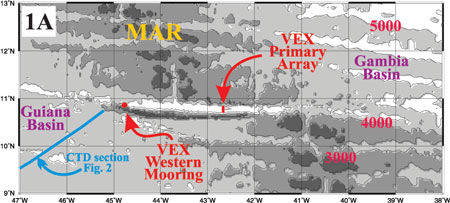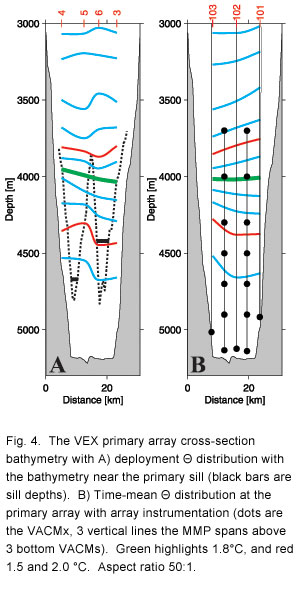Vex Mooring Array
Experiment Design
Six moorings were to be set for one year. Five would form a cross-section primary array at cross-section west of the main sill; the sixth would be placed in isolation at the primary sill. Moorings 1, 3, and 5 of the primary array would each have a moored profiler (McLean Moored Profiler [Morrison et al., 2000; Morrison et al., 2001], MMP, profiling currents, T, salinity and pressure) and a near bottom Vector Aver-aging Current Meter with temperature sensor (VACM). Moorings 2 and 4 would each have seven VACMs. The isolated mooring would have a near bottom VACM and one of the early prototype moored profilers ("M&Ms") developed at WHOI [Doherty et al., 1999]. The VACMs all would record 30 minute averages (15 min on four) and resolve well tidal signals. The MMPs, each being limited to about 1 million meters of profile, were set to make burst of 4 profiles in a day and do such bursts every second day. This would enable a time series with a profile every second day representing a day's average of four profiles to help suppress tidal signals. They would profile 1987 m from near the bottom (nominal 5100 m) through the bottom water into the lower deep water (about 3100 m). If the million-meter target were reached the MMPs would provide 503 profiles, which spanning a 252-day period. A hydrographic cruise would extensively sample the VFZ.
Deployment and Recovery
Mooring deployment Success, 04/01: The five mooring primary VEX array was installed as planned in 04/01; Fig. 4 shows the mooring placements, the instrument depths in section view with the VFZ topography cross-section, and a CTD sections at the array site. Operational considerations pre-cluded steaming east to place the sixth mooring at the primary sill. Instead it was placed in an interesting constriction at the western entrance area, where sidewalls compress the area available for cold water flow.
Mooring recovery disaster, 04/02: The mooring recovery work (a joint GAGE/VEX cruise) in 05/02 was a disaster for VEX. While all but one of six GAGE moorings were recovered, five of the six VEX moorings failed to release due to a manufacture's machining error on a critical bushing. Only the central mooring of the primary array was recovered (one MMP and one VACM). The time "liberated" by the failure to recover VEX moorings was used to do additional hydrographic stations in the VFZ entrance area (sections I-IV & VI) and to more completely survey the topography with SEABEAM.
Rescue mission success, 04/03: The methodology was to use a new ROV, ISIS, just constructed by WHOI for the University of Southampton and equipped with a variation of the Jason II system to install acoustically triggered cutters we constructed for the purpose. This would enable first getting the ROV back aboard and then cutting a mooring just below its release and recovering it as usual, with less fear of entanglement of the ROV/cable system with a mooring. We recovered three of the primary VEX array moorings this way, a fourth by direct cutting by ROV (after a failure of a remote cutter and with operation time running out). With the operations confidence built up from the first four rescues, the final VEX mooring and the single GAGE mooring were also rescued by the ROV direct cutting method. All instruments were thus rescued (three VEX moored profilers, 17 VEX VACMs and 8 GAGE VACMs).
Instrument data return: A fortuitous result of the delayed mooring recoveries was that most of the VEX VACM records were two-year duration rather than the planned single year. Of the seventeen in the water for two years, 10 gave full two-year records, the others 630, 540, 510, 460, 390, 155, and 140-day records, respectively. The single VACM earlier recovered after one year at the central mooring returned a 380-day record.
The three MMPs in the primary array completed the missions, with some issues. This is best illustrated with a plot of the maximum pressure reached versus record time, Fig. 5. The mission programming called for a profile between nominally 2900 db (the upper stop) and 5200 db (the lower stop above the VACM). The central mooring MMP basically did that, and therefore ran out of battery after about 437 profiles spanning 218 days. Total depth profiled was about 893,000 m. The other two profilers ran longer, because they struggled to reach the bottom stop, with Pmax decreasing with time, and the batteries lasting for more profiles. At the northern MMP a 112-day span of full depth profiles were obtained, about 220 days reaching to 4000 db, and 270 days reaching to 3700 db. The southern MMP struggled more than the others to reach Pmax, yielding only a 40-day span exceeding 4000 db, and 140 days exceeding 3500 db, and about 360 days that reached to 3250 db. Overall, the three MMPs at the primary array performed long enough to be used for the VEX science goals; the CTDs and the acoustic current meters on each returned profiles for the time evolutions of pressures shown in Fig. 5.
It appears that the ballasting of the instruments to make them neutrally buoyant at the midpoint of the planned profile was not adequately done. We additionally discovered a corrosion issue: the drive tension springs were a poor grade of stainless steel, and the central mooring MMP's spring was nearly detached at the time of its recovery, while the springs on the other two recovered a year later were com-pletely gone.
The fourth MMP, at the isolated VEX mooring in the constriction near the VFZ western entrance, flooded and returned no data. This unit was one of the prototype units built at WHOI, a rather different configuration than the commercial MMP. Unfortunately the hard disk data could not be recovered from the disk due to deterioration of its coating. This was an unfortunate failure, for the single VACM on that mooring recorded the strongest currents by far in the VEX instrumentation: a 630-day average down-channel flow of 25.9 cm/sec!
That completes the description of the field phase of VEX. With the delay of the completion of the experiment till near the grant's end, there are no publications other than a meeting presentation de-scribing mixing signatures in part of the CTD data [Mauritzen and Polzin, 2003]. Co PI Mauritzen left WHOI for a position at the Norwegian Meteorological Institute, but plans on writing up that CTD fine-structure/mixing work in collaboration with us. Results of the substantial preliminary analysis of the complete VEX dataset are discussed below, where we blend what we have learned from the VEX data set into the science description for the proposed VEX analysis project.

